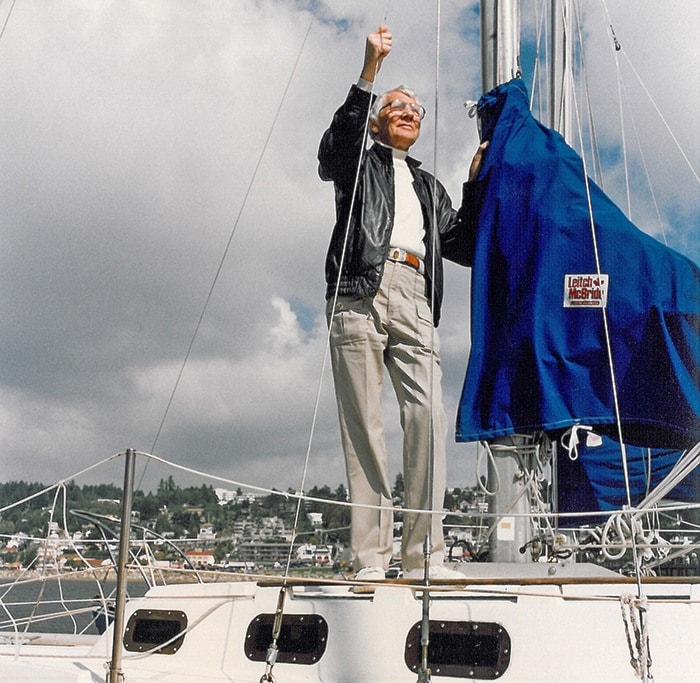It takes a lot to make Art Bates mad.
But the affable senior remembers he saw red the day he heard White Rock’s pier was on the verge of being dismantled.
That was in 1976, when the federal Department of Transportation (now the Ministry of Transportation) decided it was no longer going to be responsible for the repair and maintenance of ‘unused’ piers.
“I became incensed,” he recalls today.
The influential Bates quickly spearheaded a successful community campaign to save the city icon – and it was that civic-minded action that was remembered in a recent surprise, a special certificate of honour “for saving the pier” signed and personally delivered by both Mayor Wayne Baldwin and former mayor (and current Surrey-White Rock MLA) Gordon Hogg.
Bates, now a resident of South Surrey’s Westminster House – and, at 92, not as mobile as he once was – said that when he was wheeled down to the Fireside Room of the complex on Sept. 21, he was expecting to visit with family members and a new great-grandchild, Maggie.
They were there, all right, but so were Hogg and Baldwin (who still remembers the multiple-careered Bates as the charismatic TV weatherman on 1960s broadcasts originating from CFTK in Terrace that played across the Interior and northern B.C.).
“I got the shock of my life seeing them there,” Bates said. “I never heard a peep about what was going on – they completely fooled me.”
 In the citation, Baldwin and Hogg said the pier is now a designated heritage site and a focus of tourism and recreation that has hosted “millions of people.”
In the citation, Baldwin and Hogg said the pier is now a designated heritage site and a focus of tourism and recreation that has hosted “millions of people.”
“…Their joy is due in large part to your civic-minded approach, and their joy is part of your legacy to this community.”
The certificate is featured among his artwork and family photos in his bedroom.
“I never thought much about it,” said Bates of saving the pier, in typically self-effacing manner,
“It wasn’t just me – I had quite a bit of an army behind me. But I was the instigator.”
He recalled his reaction at finding out the council of the mid-’70s was calmly prepared to bid farewell to the historic structure, rather than ante up thousands of dollars to repair it.
“I hit the roof – I just went berserk,” he said with a chuckle, recalling he and a few seafaring friends had just established the White Rock Yacht Co-op, using the pier as the base of operations. “All my sailor language came out.”
Bates had served as an able seaman during the Second World War – signing up early with an expectation of being shipped overseas – but he spent most of his time between Vancouver and Victoria before being invalided out near the end, suffering from a back injury and tuberculosis.
Before that, the Navy had assigned him to duties using his drafting abilities – he originally trained as a commercial artist – and utilized his natural knack of communicating for training. Ironically, it was Bates’ former Navy connections that were instrumental in saving the pier.
“I’d got myself an appointment with the Department of Transportation, to see what could be worked out, outside of our stubborn council. The top guy’s name was Stan Wallace. As soon as I opened the door and walked in, he looked at me quizzically… ‘Art Bates?’ he said. It turned out I was his instructor when he first joined the Navy – we knew each other well.”
In the course of a “chit-chat,” Bates told his Navy friend the story of the pier, first built in 1914 in anticipation of the city becoming a major port but subsequently its “pride and joy” and social focus for generations.
He also learned Wallace was weeks away from retirement.
“I thought, gee, what a good time to hit him,” Bates recalled, a gleam of past mischief lingering in his eye. “He could spend with abandon – nobody would be able to harm him or demote him.”
By the end of the meeting, Bates left with an assurance – “anything you want to do, we’ll do it.”
“Armed with that, I came back here,” Bates said.
With the pier signed over to White Rock in perpetuity, Bates lined up a federal government youth-employment program that ensured needed repair work could be done with minimal financial exposure, removing one of the major objections to keeping the structure.
“It made it pretty easy,” he said.
It wasn’t just his yachting avocation that drove his anger at the prospect of losing the pier. He also treasured it as a place of exercise and reflection, from when he settled in White Rock.
“I don’t think there was a day, when I was able, when I didn’t walk on the pier,” he said.
Bates lives quietly these days, aside from visits from daughter Margo and other family members. His wife, Frankie, died in 2007, and he’s still recovering from a heart attack last year.
But he still gets a chuckle recalling his multiple careers, including his work in the forest service, his spell as a weatherman and his stint as a White Rock Sun newspaper columnist.
“I have been busy – busy every year of my life,” he said. “It’s always been things that have come to me, and I’ve always enjoyed them and been able to do them, even though I’ve had health problems. My (siblings) always used to say ‘poor Art’ – but they’re all gone, now.”
Margo notes she recently joked that the only profession he’d never had was car salesman – only to hear her dad say ‘well, actually…’”
